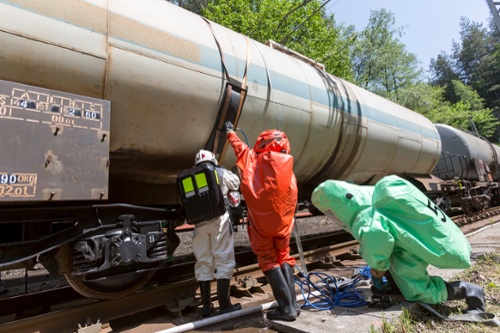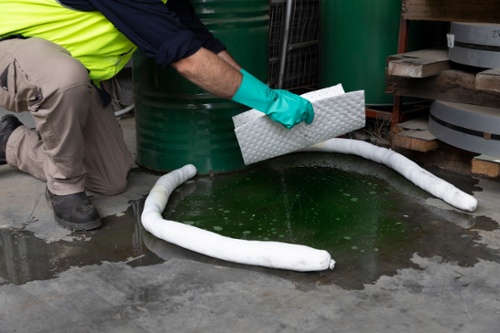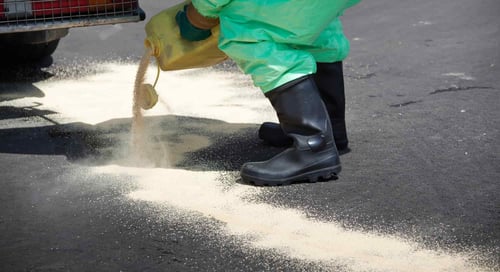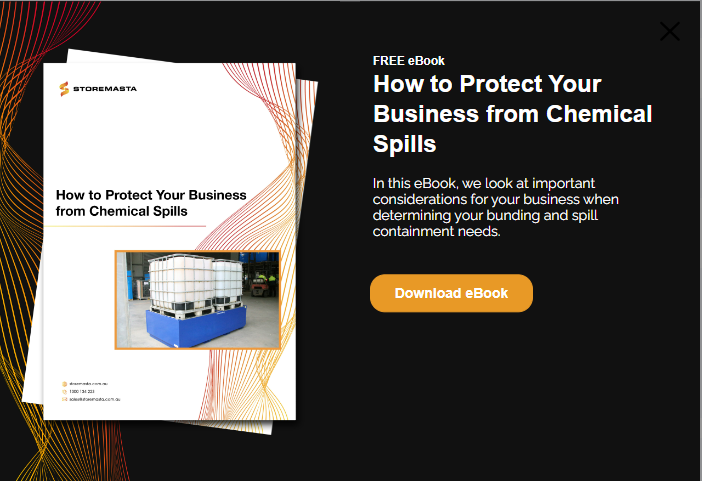Do you feel confident that your staff are completely prepared to effectively manage a successful chemical spill clean-up? If you’re a new business, or even a larger company that’s just changed their chemical stock, you may not be 100% focused on ensuring your chemical spill response plan is up to date. But as one of the key risks associated with the handling and storage of hazardous substances, spillage must be adequately controlled and managed to prevent damage to staff, property, vehicles, environment — and even the surrounding community.
In this post, we share 5 mistakes that can occur when preparing and implementing a workplace chemical spill response. Read on to learn what NOT to do — and be better prepared to manage a hazardous leak or spill when it occurs in your own organisation.
#1. Allowing Untrained Staff Into The Spill Site
Chemical leaks and spills can occur in almost every area of your business. Whether it’s in the loading dock, on the manufacturing floor, or in your outdoor areas, the spill site must be isolated, so no untrained staff enter during the spill assessment and clean-up process.
Spill training is specialist training that’s required for staff assigned for the spill response team. If you have staff members who only have general HAZCHEM training, they must not be assigned to attend the spill site.

Only trained staff should be allowed to enter the spill site due to the chemical hazards that the accidental release poses.
Leaks and spills can cause major issues for organisations — ranging from fires and explosions to asphyxiation and chemical burns. As soon as a leak or spill is detected in your workplace, you must immediately notify the supervisor and the spill response team, so the process of containing and managing the chemical spill can commence.
Untrained staff can unknowingly put themselves (and others) in danger by walking through the location or assisting with a hazardous spill. If flammable liquids have been accidentally released, an untrained staff member could unintentionally bring an ignition source into the area — sparking a blaze of the flammable vapours. Alternatively, toxic substances may not be correctly identified by unathorised personnel, who could put themselves at risk by coming into contact with toxic liquids and vapours.
The isolation of the leak or spill site — along with the notification of management and the spill response team — should be the first action taken during the spill clean-up process.
#2. Not Properly Assessing The Risk
When it comes to workplace chemical spills, there are generally two types of incidents: major chemical spills and minor spill incidents.
A major spill requires an emergency response – including the evacuation of the premises, the notification of authorities, and the written
In the Guide For Major Hazard Facilities: Emergency Plans, Safe Work Australia explains the difference between a major (emergency) and minor spill incident:
“Interpretations of the term 'emergency' vary depending on a person's background and experience. In general, an emergency is a situation that harms (or threatens to harm) people, property or the environment. Other circumstances, such as a minor spill of hazardous material on-site which is dealt with by standard operating procedures without the need to activate the emergency plan, would not be regarded as an emergency for the purposes of this guideline.”
If a spill is small, manageable, and not having the potential to create a hazardous situation, then it may be classed as a minor spill and handled by your inhouse team.

A minor spill is one that can be successfully managed by your inhouse spill response team.
A major spill, however, involves the activation of your emergency plans. If the risk level of the spill is not accurately determined, you won’t be capable of activating a timely response to the hazardous spill situation.
There are three levels of emergency, recognised by Safe Work Australia. These are:
- Local – impact is expected to be confined to a specific location without your facility. Escalation of the incident is not expected. In local emergencies, emergency services may be required.
- Site – impact is expected to spread or affect all parts of your facility. It is not expected to affect off-site. In site emergencies, emergency services should be required.
- External – impact is expected both within your facility and beyond the boundary of your facility. In external emergencies, emergency services will be required.
Spills can quickly turn into major incidents, threating the safety of neighbouring homes, businesses and the community. Without a correct assessment of the spill hazard, the level of risk that your organisation may be facing will not be adequately addressed.
#3. Not Having Immediate Access To All Chemical SDS
Your Safety Data Sheets are essential documents which must be accessible in the event of a leak or spill. Your team will have to make sure they know the type of chemical that has spilt, as well as understanding the spill volume and the potential hazards associated wtiih the incident.
All chemical documents must be in place, up-to-date and clearly visible, so staff don’t waste valuable time looking for these documents.
The correct identification of the spilled chemical, including the chemical class and associated hazards, is crucial in assisting the safe clean-up and disposal of leaks and spills in the workplace.
REMEMBER: You’re obligated by WHS Regulations to have the SDS of each chemical onsite available to staff members and emergency services. We recommend securing your SDS in a dedicated folder and then inserting this into a document box, which may be attached to your chemical store.
#4. Lacking The Materials To Contain and Stop The Spill
If your spill kits aren’t filled with the correct materials to confine, absorb, clean-up and dispose of an accidental chemical release, you won’t be able to prevent the spill from impacting other areas of your workplace.
Spill kits should be regularly inspected and refilled with a range of chemically-compatible materials, including:
- Booms and mini-booms
- Absorbents
- Floor Sweep
- Clean-up tools
- Waste bags and ties
- Wheelie bin
- Spare chemical containers
- Gloves and PPE
Spills or leaks should be quickly contained using booms and other containment materials. The absorbent items can be placed over the spill or used to stop chemicals from leaking out of machinery, equipment or storage facilities.
If you’re using floor sweep, make sure it’s suitable for the chemical product that’s been spilled (this should already be checked when your spill kit is inspected and re-filled). Sprinkle the floor sweep over the spill, and using a broom, work the absorbent granules into the middle of the area. Always dispose of soiled materials and absorbents with the waste bags provided in your spill kit.

Regularly inspect your spill kits to make sure that they are complete, correct and in good working order.
When there is a change to your chemical inventory, aggregate volume of kept chemicals, or your work practices, make sure you update your spill kits to ensure they’re still suitable for the job.
IMPORTANT: You may have to customise your spill kit to suit the quantity of chemicals that you have onsite. Spill kits can be purchased as ready-made products, with refills of individual products also available. Make sure you have enough stock on hand, to refill your spill kits whenever they are used.
#5. Forgetting To Properly Report and Assess The Spill Incident
When a spill incident occurs in your workplace, it’s an opportunity to learn more about why the spill occurred – and how you can minimise the impact and likelihood of it happening again.
Minor spills should be recorded and logged, so management can review the spill incident. A meeting concerning the spill should be scheduled, to review the effectiveness of spill controls and the spill response in general.
Changes to your spill prevention and chemical spill response plan may be required, pending an investigation by your team. Use this reporting and investigation process as a way of improving the overall safety of your chemical handling, dispensing, transfer and storage areas.
IMPORTANT: An uncontrolled chemical spill or leakage is classed as a notifiable incident under the WHS Act. The regulator in your state or territory must be notified after a chemical spill has occurred.
Chemical Spill Clean-Ups
While chemical leaks and spills do happen in all types of workplaces, there are systems and procedures that you can put in place that will minimise the damage that an accidental chemical release can cause. Developing a strong spill response plan, in consultation with your staff, can strengthen the safety of your site.
If you’d like to learn more about managing chemical spills in the workplace, we have an eBook that can help. How to Protect Your Business From Chemical Spills details your legal obligations in regard to spill prevention. It will also introduce you to our 4-step risk control methodology and explain the range of secondary containment solutions that can help you contain leaks and spills. Grab a copy of our guide today by simply clicking on the image below.
Joining the team as a Dangerous Goods Storage Consultant, Melissa Hampton became Storemasta's Marketing Manager in late 2021. With extensive knowledge and experience in chemical compliance, Melissa is responsible for leading the Marketing team and helping shape their marketing strategy. In her spare time, you can find Melissa hiking, swimming and enjoying the great outdoors in beautiful north-west Tasmania.
